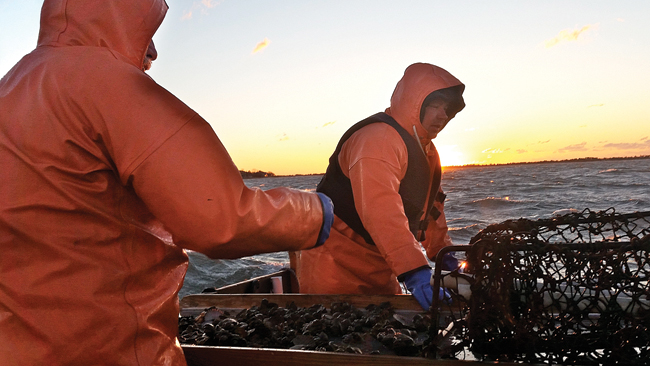It may not be boom times, but still plenty of scallops

Early Monday morning, under cover of darkness and beneath a star-lit sky, Ed Densieski and Gary Joyce boarded their custom-outfitted boat, dressed head to toe in vibrant all-weather gear.
Unfazed by the blustery chill, the pair headed out through Southold Bay, with Brick Cove Marina at their backs.
It was the start of their 16th scalloping season and, as Mr. Densieski said, “There’s only one opening day.”
Plenty of salt spray and one 15-minute boat ride later, the duo began checking the time.
“You can’t start before 6:23,” explained Mr. Joyce, a 65-year-old Aquebogue resident, noting the official time of sunrise.
Eight minutes later, four scalloping dredges hit the water.
“What’s better than this,” said Mr. Densieski, 54, of Riverhead as he leaned on the throttle, moving the boat and the dredges along with it.
The 2014 scalloping season had begun.
Famous for its sweet and tender meat and unique winged hinge, the Atlantic bay scallop is a fixture in the East End fishing landscape.
According to the state Department of Environmental Conservation, commercial fishermen were harvesting an average of 300,000 pounds of scallop meat annually between 1966 and 1984, contributing to over $4 million a year to the state economy.
During that time, the Peconic Estuary accounted for 25 percent of all bay scallops harvested in the United States, according to The Nature Conservancy.
The abundance of fresh shellfish supported nearly 100 pop-up scallop shops, which dotted roadways across the East End, longtime bayman Charlie Harvey, 74 of Greenport, recalled.
Mr. Harvey still makes a living off nearby bay waters.
“My father ran a big scallop shop down at the end of Sixth Street in Greenport. Boats could come right into the bulkhead,” he said. “There sure was a lot of people doing it … and back in them days we sailed, we didn’t use power [boats]. You had to depend on the wind.”
But the summers from 1985 to 1987, and again in 1995, brought change, as a harmful overgrowth of algae known as “brown tide” choked Peconic Bay waters of oxygen, killing the shellfish and eelgrass that were unable to escape it.
“[Brown tide] hit so heavy you couldn’t even see through it,” Mr. Harvey said. “When I pulled them out of the water, all the scallops had died.
“I can remember my father going out on opening day and coming in with just three-quarters of a bushel of scallops. And that was a whole day’s work.”
During the years from 1996 to 2007, according to state DEC data, commercial anglers harvested an average of only 3,333 pounds of scallop meat — about 1 percent of historical catch averages.
Mr. Harvey said he and many others who had made a life on bay waters were forced to seek jobs on land.
“A lot of people went in different directions because you could not make enough,” he said. He went into construction and, while he still goes scalloping, this year’s season will be delayed for him as he focuses on conch, otherwise known as whelk, a sea snail that has realized a growth in demand in Europe and Asia.







